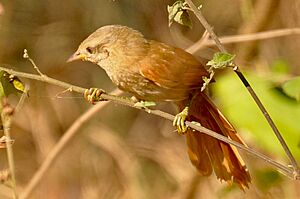Plain softtail facts for kids
Quick facts for kids Plain softtail |
|
|---|---|
 |
|
| T. fusciceps in Mamoré, El Beni, Bolivia | |
| Conservation status | |
| Scientific classification | |
| Genus: |
Thripophaga
|
| Species: |
fusciceps
|
 |
|
| Synonyms | |
|
Phacellodomus fusciceps |
|
The plain softtail (scientific name: Thripophaga fusciceps) is a type of bird. It belongs to the ovenbird family, called Furnariidae. You can find this bird in countries like Bolivia, Brazil, Ecuador, and Peru.
Contents
About the Plain Softtail
The plain softtail is a small bird, usually about 16 to 18 centimeters (6 to 7 inches) long. It weighs around 23 to 24 grams (about 0.8 ounces). Male and female plain softtails look very similar.
What Does It Look Like?
Adult males of the most common type (called the nominate subspecies) have a light brownish-gray face. They have a faint light line above their eye and a thin dark line through it. Their head is light gray-brown with some faint light marks.
Their upper back is light gray-brown. This color changes to a reddish-brown on their lower back, rump, and tail feathers. Their tail is a reddish-orange color. Their wings are mostly dark reddish-orange with dark brown tips on the flight feathers.
The plain softtail's chin is light buff-brown. Its throat, chest, and belly are light brown with some faint lighter streaks. The sides of its body and the feathers under its tail are a slightly darker brown. Some birds might have grayer underparts.
Their eyes can be many different colors. The upper part of their beak (maxilla) is bluish-gray to light gray. The lower part of their beak (mandible) is light gray to light bluish. Their legs and feet are olive-green to yellowish-olive.
Female plain softtails have lighter foreheads and underparts than males. Young plain softtails have faint spots on their throat and chest instead of streaks.
Different Types of Plain Softtails
There are three different types, or subspecies, of the plain softtail:
- T. f. fusciceps (the nominate subspecies)
- T. f. dimorpha
- T. f. obidensis
The T. f. dimorpha subspecies is much smaller than the nominate type. Its colors can vary a lot. Generally, it is much darker overall. It has little to no light line above its eye and a very reddish back. Its underparts can be more reddish, browner, or grayer than the nominate's.
The T. f. obidensis subspecies is even darker brown than dimorpha. It only has brown underparts. Because these subspecies are different sizes and live in separate areas, some scientists think they might be different species.
Where Plain Softtails Live
The plain softtail lives in different parts of South America.
- The nominate subspecies (T. f. fusciceps) is found in northern Bolivia.
- The T. f. dimorpha subspecies lives separately in eastern Ecuador, northeastern Peru, and southeastern Peru.
- The T. f. obidensis subspecies is found in central Brazil, along the lower Madeira River and central Amazon River.
These birds live in tropical evergreen forests and forests near rivers. They especially like areas with dense tangled vines. They can also be found in drier forests. They usually live at elevations between 50 and 500 meters (about 160 to 1,600 feet) above sea level.
Plain Softtail Behavior
Plain softtails stay in the same area all year round; they do not migrate.
What Do They Eat?
Plain softtails eat arthropods, which are creatures like insects and spiders. They usually look for food in pairs or small groups. Often, they join mixed groups of different bird species that are foraging together.
They search for food at all levels of the forest, from the undergrowth to the lower parts of the tree canopy. They pick their prey from dead leaves, bits of debris, and small branches. They are very agile, moving skillfully along branches and especially through vines.
Reproduction and Nests
We don't know much about how plain softtails reproduce. Their nest is shaped like a globe. It is made of twigs and soft plant material. The nest has two entrance tubes low on its side. They build these nests in a fork of a branch high up in the tree canopy.
Plain Softtail Songs
Each subspecies of the plain softtail has a different song:
- The nominate subspecies' song starts with slow, dry ticking sounds. It then gets faster and higher, ending in bursts of sputtering tick notes.
- The T. f. dimorpha subspecies sings a sharp, loud, and descending churring sound.
- The T. f. obidensis subspecies has a very rhythmic chattering song with rattling sounds.
All three subspecies typically sing together in a duet.
Plain Softtail Status
The IUCN (International Union for Conservation of Nature) has listed the plain softtail as a species of "Least Concern." This means they are not currently at high risk of disappearing. They live across a large area, even though their populations are spread out. Scientists believe their numbers are stable. No immediate threats to the plain softtail have been found. However, it is considered a rare bird in some places.


